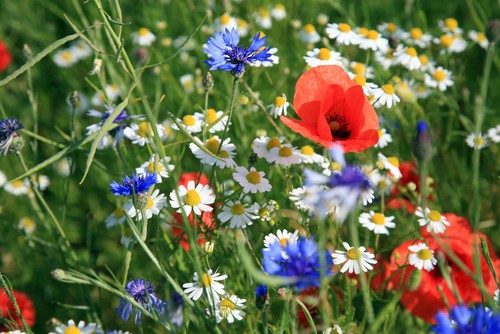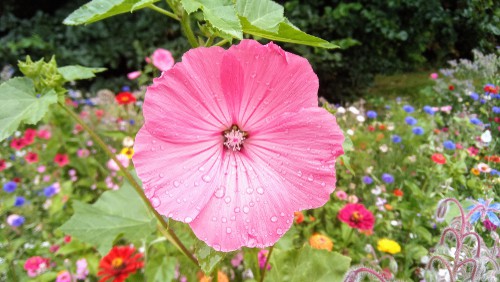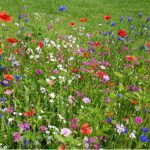Last updated on April 3rd, 2022
Our site is reader supported, this means we may earn a small commission from Amazon and other affiliates when you buy through links on our site.
Wildflower gardens make a wonderful home to flying, winged insects and pollinators, all of whom serve an important ecological purpose. You can create a spectacular wildflower garden with minimal soil preparation. The key is to know ahead of time that wildflowers, while naturally occurring all over the world, are in fact quite fussy about their soil and nutrients. If they do not like the area in which they are growing, they will not perform well. That is why you have to take measures to prepare the ground beforehand.
How to create a wildflower meadow – step by step
Types of Wildflowers
There are two types of wildflowers you can grow:
- Annuals: these germinate, flower, and die all in a single year.
- Perennials/Biannuals: these need a longer period of time to mature, but they live for many years. Perennials continue to grow year after year only dying back for the winter.

Annuals
You need to know the type of seeds you are sowing because they have different soil requirements. Annuals aren’t as fussy and will adapt to most areas because they often thrive in farmland, with a lifecycle that coincides with that of annual farming.
Here are some fun facts about annual wildflowers:
- Wildflowers are often annual which means they grow, flower, seed, and die, all in a single year.
- They often prefer being sown in autumn or in spring.
- They need to be sown into the soil directly, generally by just scattering the seeds over the desired area.
- If germinating from seed (with wildflower seeds) they need a sunny location.
- Wildflowers grow best in full sun with nutrient-rich soil.
- They compete well with things like barley and wheat.
- Most are self-seeding, but you need to distribute the soil to encourage germination.
Preparing the Soil
Once you are ready to prepare your soil, start by choosing a sunny location. The wildflowers you grow will need this sun to thrive.
The area needs to be stripped of all vegetation, especially roots of perennials weeds. The area needs to be dug to a depth of at least 15cm. Remember, the goal here is to copy the same style of preparation as a plough would do on a farm.
The soil should be free draining and aided with organic matter to help it retain moisture. Once that is done, the soil should be raked with a garden rake. You can even consider using a rotavator or tiller to break up and turn the soil.
See our recommended rotavators in this buyer’s guide here
The seeds should be sown right where you want them to flower. They should be thinned according to the packet instructions for the seeds of your choosing. The seeds are often very tiny and mixed with a sand mixture to help spread them more evenly.

Perennials and Biannuals
Perennials and biannuals tend to thrive in low-maintenance areas. They do well when grown amongst grasses too. Perennials tend to flower early in the season, which means that local bees do a lot to pollinate them. They will propagate from seed and then regenerate from the existing roots annually. Realistically, with perennials, the only maintenance you need to do is to cut the flowers in summer (most gardeners with a large swath of land just mow the area). This will go a long way towards a second flush of flowers.
Preparing the Soil
Once you are ready to prepare your soil, start by locating an area with lots of sunlight. Remove all existing vegetation including leaves and roots. It is better to find an area to dedicate to the flowers rather than try to add them near your garden because they thrive in low nutrient soil.
Dig a depth of 12cm on average to loosen up the soil. Lightly fork over the area, especially if you are adding some low nutrient soil on the surface of the trench you have dug.
Put the plants in the ground or spread the wildflower seeds in spring as directed on the seed packet. Cut back the wildflowers and grasses at least once each year, often in late June, to keep soil nutrient content low. This seems counterintuitive, but perennial wildflowers grow in low nutrient areas and your job is to recreate their natural environment.
Popular wildflower seeds to buy
- With easy-to-follow planting instructions, our wildflower seeds are perfect for both novice and experienced gardeners alike. Simply prepare the planting area, scatter the seeds, and watch as your garden comes to life with a vibrant mix of annuals and perennials. Our seeds are also packaged in a resealable bag for easy storage and future use
- ! Species of Flower: Purple Tansy, Californian Poppy, Cornflowers mix, Clover mix, Sainfoin, Poppy red, Corncockle, Blue Lupin, Gypsophilla, Nasturtium, Love in a Mist mix, Linum Blue, Four O' Clock, Safflower, Common evening, Pot Marigold. Sheep's Sorrel, Cosmos bipinnatus mix...
- A variety of colorful and fragrant annual and perennial wildflowers, great sourse for bees, butterfly ... to bring life to our wildlife and nutuer
- Packaged in a resealable bag for easy storage and future use Perfect for adding a sustainable and environmentally-friendly touch to your home or business
- Great for adding color to borders, meadows, and other natural areas Makes a wonderful gift for gardeners and nature lovers of all ages
- EFFORTLESS SPREADING – Twin shaker boxes with wood shaving filler prevent wildflower seed clumping, delivering precise coverage across 100m². Watch your wildflower meadow flourish.
- POLLINATOR PARADISE – Turn your garden into a haven for bees and butterflies. These wild flower seeds for planting in the UK create a vibrant ecosystem teeming with beneficial insects.
- YEAR-ROUND BLOOMS – Plant in spring for summer flowers or in autumn for next year’s display. Enjoy a garden bursting with colour while supporting local pollinators.
- MEASURED FOR SUCCESS – Each box contains 20g of British wild flower seeds mixed with 450g of natural bran carrier, ensuring even distribution across your space.
- SUSTAINABLE DESIGN – Packaged in compostable materials, this eco-conscious wildflower mix helps create a thriving, long-lasting garden. Simply shake, spread, and watch nature thrive.
- Sow at 1-2g per square metre
- Over 25 Species of Flower
- Floral Mix
- EASY TO GROW - Simply scatter and water! The product is a mix of flower seeds and granular compost
- CREATE A WILDFLOWER GARDEN - Includes seeds of Ox-eye Daisy Corn Poppy Corn Flower and Corn Marigold
- COVERS 16m2 - This is the equivalent of 1 6 car parking spaces
- Color: Natural
- Package Weight: 4.26 kilograms
- Sow at 1-2g per square metre
- Over 25 Species of Flower
- Floral Mix
Image credits – Shutterstock.com
Last update on 2025-04-02 / Affiliate links / Images from Amazon Product Advertising API







